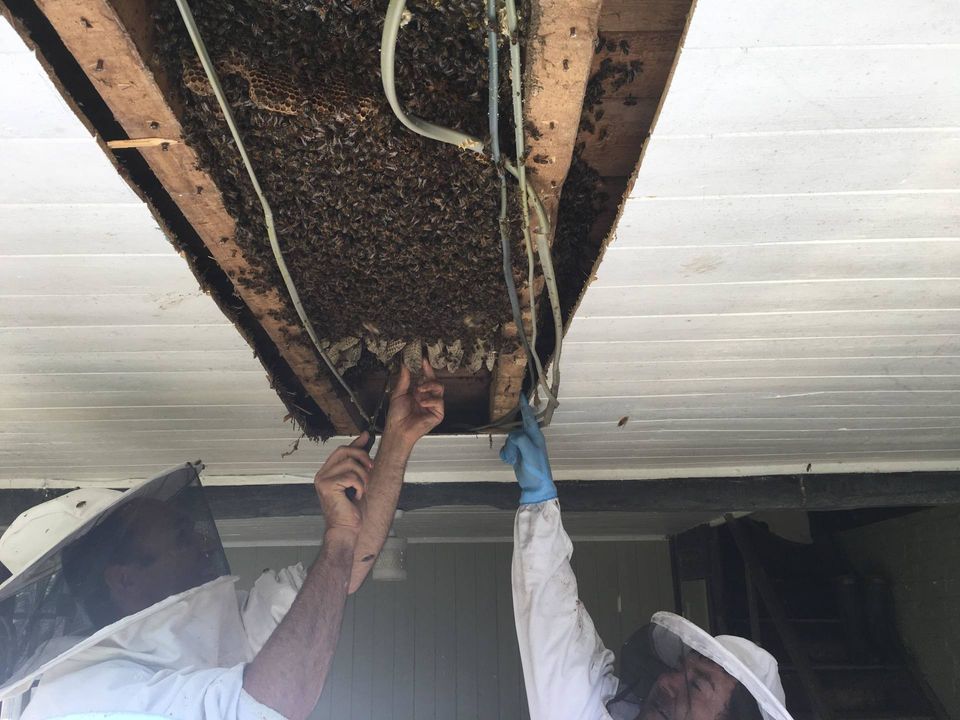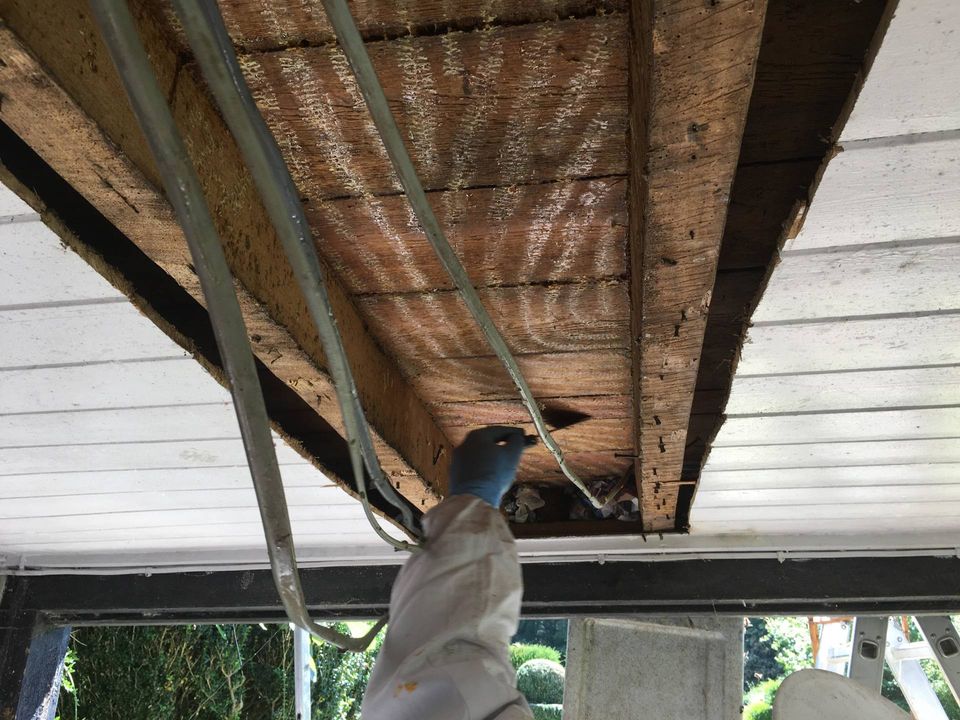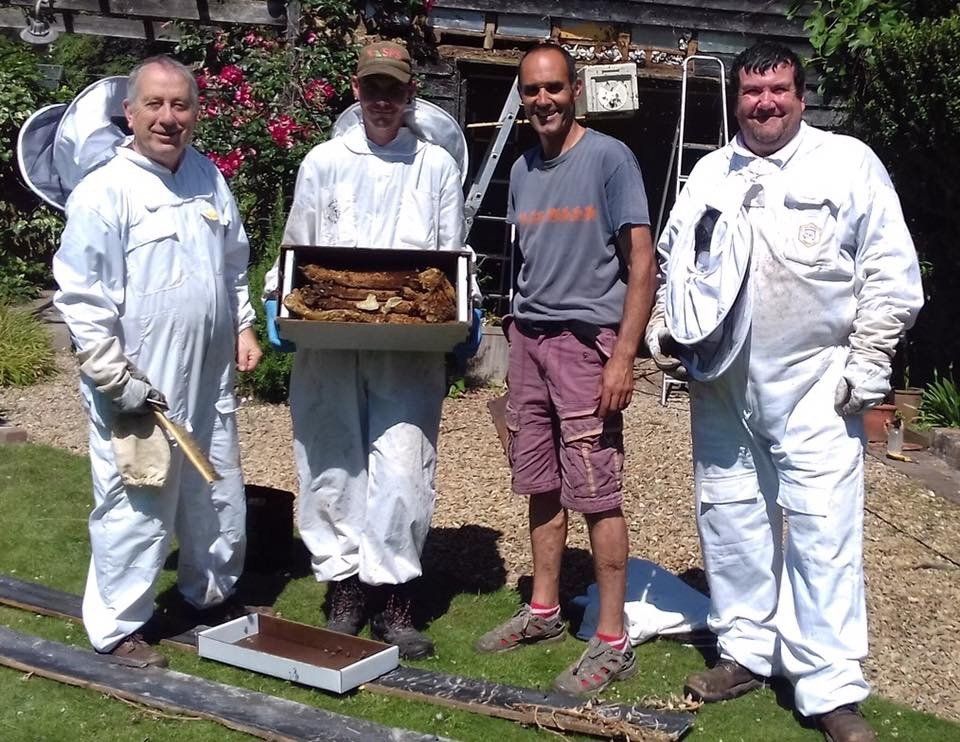Saving Honeybees
LOCAL HONEYBEE SWARM CUT OUT
Hi everyone and welcome back. If you are followers of our social media you would have seen that the other month we carried out a honey bee cut out. We thought we would take this opportunity to do a quick blog on what a cut out is, why we have done it and how it went so let’s get to it.
How do these bees get here in the first place?
So here is a very quick simple lesson. Each year a beehive/colony will produce a new queen. Once this has happened the old queen will send out scout bees to look for a perfect place to live, once they have found a suitable place a swarm will occur and the new queen will take over the original hive. Once the scout bees have found a suitable location The old queen along with some of the bees from the original hive will fly off in numbers to the new nest site, this could include a few rests stops on the way. This can look scary and can vary in numbers from a few hundred up to thousands. They can sometimes end up exploiting a gap in your property they deem suitable and set up a new home. They will build comb for honey and brood and your property will become a hive. And the only way to remove them is to carefully cut them out of the building.
So what is a cut-out??
A cut out is when a honeybee colony that resides in a property, in gaps and voids has to be cut out to be removed due to many reasons. A couple of quick examples are, Property damage from honey leaking through ceilings/walls to attracting other pests and through to health and safety of the public.
The back story?
We were called to arrange a meeting to see how we could help save a honey bee colony behind some cladding (horizontal layered wood on the outside of a building like a fence). we met up with the client and discovered through conversation that a swarm arrived a month ago which they didn’t originally mind. However, the activity was threatening a local village fete that was due to take place the following weekend on the property. This caused a health and safety issue, we don’t treat honey bees unless absolutely necessary and the client also didn’t want them destroyed. A Brilliant result for all. As we spoke a while longer and came to the conclusion of a cut-out. The client was happy for this to go ahead and although there would be property damage it was worth it to save the bees. (Everything we cut out was replaced safely but there was obviously the marks left where we had to cut)
The cut out in question?
This cut out started as a very simple one theoretically. Bees had taken up residence behind some cladding of an outbuilding. We were expecting to turn up, remove some cladding and collect the colony that was between the structural wall and the cladding. Well, boy was we wrong in this situation, we removed the suspected cladding and discovered the swarm had set up home in a large void between a second story room and a ground floor outbuilding. Not to worry though these things happen and we have to adapt.
We then went to the wooden tongue and groove ceiling and removed the first four sections. This was to access how much comb and the size of the colony we were dealing with. Well, we uncovered this and it was all comb and bees so it was much larger. We repeated this and removed another four and the same again. In the end, we had uncovered an area of around 2 metres x 2ft jam-packed with comb and bees. This isn’t a simple cut out like we expected or normally deal with, this we knew was different. The number of bees alone was crazy, let alone the comb. The month-old swarm occupying this space was amazing yet we had to adapt to the situation as it happened
We are used to dealing with swarms and generally, these swarms are around the 5-10,000 range however this was much larger and we didn’t want to endanger the swarm as by this point some of the comb containing honey started falling from the ceiling under its own weight. We decided in this situation that we should contact a local beekeeper and friend for advice in this situation as to not endanger the colony or the queen. We contacted the creator of the bee watch app ( www.bee.watch ) and both he and his apiary partner came to see what we are dealing with.
It’s not often you hear a beekeeper go “WOW” when viewing a colony first time but it happened in this situation and they where happy we called upon them. Their inspection estimated 100,000 bees in this colony/month old swarm. Don’t forget we are only pest technicians, we help save bees because of our morals along with the fact they are our latest commercial pollinator. We are not experienced beekeepers but do have a great understanding and work alongside seasoned beekeepers to make sure anything we do that involves bees is done to the best standard for the bees to survive.
At this point, we had to come up with a group plan. We had to hurry as every second wasted we were catching more and more of the comb containing honey falling from the ceiling. The plan was hatched, we let the beekeeper with the most experience commence with removal and the three of us assisted. This beekeeper started at the age of six and has been doing it ever since, sorry not revealing his true age we might get told off but let’s just say we would trust him with our life when bees are concerned. For the next 4 hours, we were swapping out smokers with knives taking away comb and placing in multiple nucleus boxes (temporary hives), inspecting for disease as we went. We where locating eggs, and larvae as we were slowly removing this huge and spectacular shaped natural comb. We had to inspect what we were removing so we could get an idea of where the queen was. We didn’t want to risk the queen's life and finding the queen would also assist us in getting more of the bees into their temporary accommodation. Well, the queen was spotted on a couple of occasions and disappeared just as fast but not to worry, with every sighting we knew she was still there. This carried on until the last part of the comb was removed and placed in the nuc box. Suddenly the bees in the nuc seem more calm and steady they weren’t trying to get back to the sight of removal so that must mean one thing, we have the queen.
Next was to clean out all signs of honeycomb and seal up the original entry point and replace the ceiling boards. This was carried out successfully.
Next was the outside cladding area and containing the bees coming back from foraging. For this, we added some comb containing brood to another swarm box and left it outside the original entrance. This was done to collect any foraging bees left over after the main bulk was taken away. This was collected at dusk the same day so as many of the remaining bees had returned, found the brood and started to tend to it so that the most of the remaining bees were also removed.
Was it a success?
In a simple word, yes.
It went extremely well and was hard work for an extremely hot day. We started at 6:30 am and finished at just gone 2 pm with non-stop work and dressed in full suits. The bees are now located at our local apiary and as soon as they are settled in we will be giving an update through our social media channels.
The client was over the moon we managed to remove them without destructive measures being taken and even took a photo to add in the local leaflet
We could have gone into more detail but we didn’t want to write a book.
Hope you have all enjoyed this read and we will be back soon with another exciting scribble.
If you have the pest we have the solution
From all at
Shire pest solutions
All Rights Reserved Shire Pest Solutions



